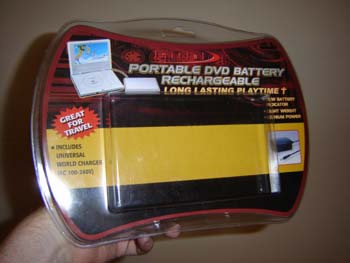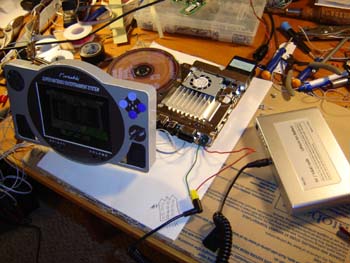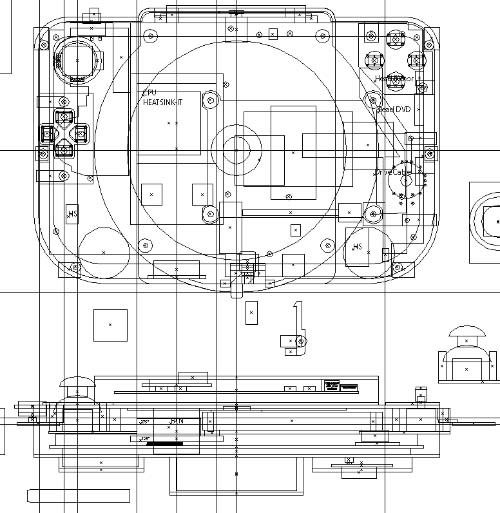| |
Benjamin J Heckendorn's
Playstation 2 Portable |
|
Usually I make some sort of Photoshopped "adventure" for
the makings of these things (see the infamous SNESp or NOAC NESp
stories) but with the PS2p I decided to go for a more
step-by-step telling of the actual construction process. I often get
questioned as to how I build these things, so I thought I'd make this as
informative as possible.
I first starting making a PS2
portable at the beginning of 2004 using a regular PS2. It was going OK
and I even had a Ni-MH battery that would run it but I was having
problems with the DVD drive. I kept at it all spring, then I had to work
on my book.
With the book done (in
October) I could get back to doing a PS2 portable. My goal was to have
it done before the real PSP was released. (For fun and shock value) Also in October
the new smaller PS2's were coming out. I discovered they had an external
AC/DC adapter and ran off 8.5 volts. This seemed reasonable to me so I
bought one - the fine folks at the Game Store Formerly Known As
Funcoland got them in a few weeks early much to my delight. This gave me
a head start over other portabilizers!
The next step was finding a
power source that would work and hopefully provide at least a couple
hours of play time. The battery is usually the second trickiest factor
in making one of these (the unit itself being the first) because you
can't really "hack" a battery - it's gonna be the size it is
and you have to deal with it.
I remembered seeing a Lithium-ion battery pack at Wal-Mart. It's
intended to power portable DVD players and the like, but all I cared
about was how it outputted 9 volts and stored 5400mA of power! Here's
what the package looks like: (The battery itself is just a gray box with
lights and plugs)

I kept my receipt in case it
didn't work so I could return it. (Pretty crafty of me, I know. Don't
tell the big "WM"). I then
hooked a 5" PSone screen to the small PS2 and powered them both off
the battery, as shown below. It consumes about 1.9 amps on average.

(Note: The SNES portable is hooked up because I
was just using its screen)
So now I knew it could work.
The next step was to design the case. I measured all the parts (battery,
battery circuits, PS2 motherboard, DVD drive, controls) with my trusty
dial caliper and then designed the case using Abode Illustrator, which
is the program I used for all the portables in my book. The top-down and
side depth layouts of the PS2p can be seen below. There's a lot more
drawings required but this shows the two most important parts. Things like the
joypads, analog sticks, buttons and DVD disc should be somewhat
recognizable. In the middle you can see the lid latch assembly. (The
thing with the tooth)

This was all done in 2D
wireframe as vector objects. Some may be wondering why I didn't use a 3D
program... the answer is I'm used to doing it in 2D, I don't have a 3D
program and the CNC cutting machine I intended to use takes 2D graphics
to run. Sure it requires a little more thought and extra "side
view" drawings to establish proper depth but my brain needs a
workout every so often anyway.
Me in 90 years to young
whippersnappers: "When I was your age, we had 2D art programs! And
we liked it! And we didn't complain!"
The design of the unit took
about a week (Interspaced with me playing GTA: San Andreas) All the
original designs I did in the spring were thrown out as this unit was going to be
smaller and thinner anyway. This unit looks similar to the original
design but it smaller so I just started from scratch. Some see an empty
computer screen as intimidating but I see it as an opportunity to do
things better than last time!
I then used a 60-watt laser
engraver to cut all the parts out of 1/16" engraving plastic and
1/4" thick black acrylic. The next step is to assemble these parts
to construct the case...
Case
Construction and Installing Stuff!

|